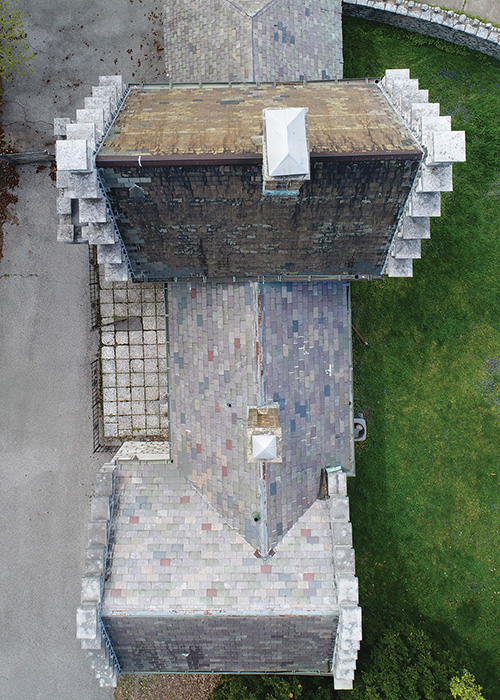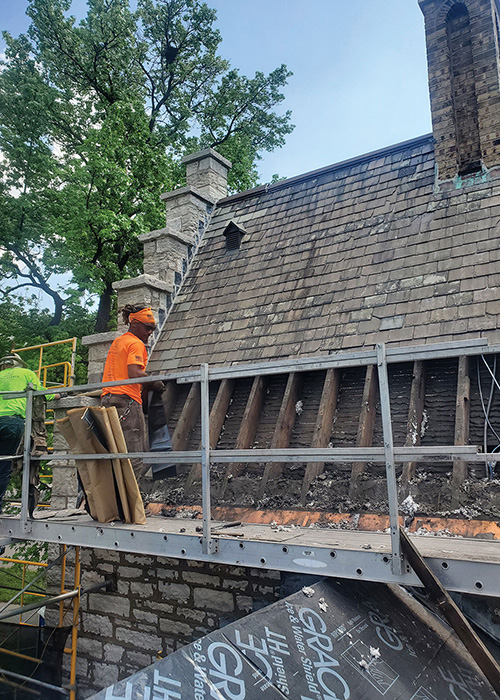
Tower Grove Park in St. Louis was founded in 1868 as a gift from a retired merchant philanthropist, Henry Shaw. The only conditions Shaw imposed on his gift were that it be used as a park forever and an annual appropriation be made by the city for its maintenance. Today, Tower Grove Park is the only U.S. public city park managed by an independent board of commissioners and staff. In 1972, it was listed on the National Register of Historic Places.
In April 2022, Renaissance Historic Exteriors, Belvidere, Ill., replaced the slate and sheet metal on the park’s West Gatehouse roof.
Preparations
Standing at the west entrance along Kingshighway, Tower Grove Park’s West Gatehouse is one of four primary entrances to the park. It was built in 1870 and expanded in 1880. The 950-square-foot building was designed by Francis Tunica, a supervisory architect at Tower Grove Park, in Gothic Revival style.
To reroof the structure, the Renaissance Historic Exteriors team conducted significant research to match the original slate material and colors. Once appropriate slate was identified and selected, the team adapted historical details to accommodate modern local code requirements.
“As a National Historic Landmark, the project had to adhere to the Secretary of the Interior’s Standards for Rehabilitation, and Renaissance Historic Exteriors rose to the challenge,” says William Rein, director of operations and special projects for Tower Grove Park.
From the steep-slope roof areas, the team removed the existing slate tiles, some of which were original from 1860, underlayment and flashings down to the wood plank roof deck and salvaged the existing copper louvered gable vent for reinstallation.
From the low-slope roof area on the east elevation, the crew removed the multilayered built-up roofing material down to the concrete deck and inspected the roof decks for deficiencies.
Time to cultivate
Following tear-off, the team applied GRACE ICE & WATER SHIELD® self-adhering underlayment along all valleys, eaves, roof penetrations, pockets and parapet walls and then covered the remaining exposed roof deck surface.
Next, Renaissance Historic Exteriors craftsmen installed new 20-ounce copper chimney flashings, counterflashings and chimney caps to match the existing shapes, sizes and configurations. Original specifications called for installing closed valleys with new 20-ounce copper flashings under each course of all valley slates in accordance with National Slate Association guidelines. The team recommended installing 20-ounce copper open valley diverter metal in lieu of interwoven closed valley flashings and furnished this at no additional cost.
“We don’t recommend walking on a completed slate roof at any time,” says Robert Raleigh, president of Renaissance Historic Exteriors. “Open slate valleys provide better access to any persons accessing the roof area in the future.”
New 20-ounce copper step flashings were installed at each slate course along the wall-to-roof transitions. For the flashings along parapet walls, the team recommended dead soft copper.
“It is malleable enough to shape to the contours of the existing stone parapet walls,” Raleigh explains.
Craftsmen also installed 20-ounce copper pocket flashing along the northwest valley-to-parapet transition and a 20-ounce copper gutter apron along all eaves to receive new gutters.
“The workmanship really came to life during construction and installation of the new roof systems,” Rein says. “Every member of the team I observed displayed a high level of craftsmanship and took pride in their work.”
For the low-slope area, the team applied AlphaGuard™ Si Roof Restoration, a four-part liquid-applied silicone roof system, over the concrete deck.


Next, team craftsmen reinstalled the original copper louvered gable vent and installed new 4-pound lead vent pipe flashings at all existing locations.
To complete the slate roof system, the team installed new S1 Vermont Slate in Royal and Variegated Purple and used Hilltop Slate in Vermont Unfading Green to create the TGP lettering.
“The TGP initials for Tower Grove Park that originally adorned the roof of the two-story structure along with decorative horizontal top and bottom borders were recreated and are perhaps the most striking features of the building,” Rein says. “I remember speaking with the site foreman and production manager who was hand-sketching notes for himself to get this incredibly important detail just right.”
Renaissance Historic Exteriors’ team of craftsmen also fabricated and installed new 20-ounce copper ridge caps anchored using anti-corrosive fasteners; fabricated and installed a new 6-inch, half-round copper gutter system complete with fully soldered copper outlets, endcaps and downspouts; and fabricated and installed new 20-ounce copper flashings around four sides of an octagon-shaped obelisk located on the southwest corner of the south hip roof.
Tower Grove Park facts:
- Tower Grove Park is the largest 19th century Gardenesque-style city park in the U.S. It covers 289 acres and is the second-largest park in St. Louis.
- The park is home to nearly 400 species of trees, bushes and flowering plants. More than 7,500 trees represent more than 325 varieties, including native specimens, which provide shelter to a diverse wildlife population.
- Located along the Mississippi Flyway, the park is a popular birdwatching site, especially during spring and fall when many migratory birds rest in the park along their journeys.
- Henry Shaw, who gifted the park to the city of St. Louis, had an interest in Victorian architecture that is reflected throughout the park among many buildings, entrances, statues and busts. Several statues from the 1800s, including one of William Shakespeare, line the central corridor.
- Tower Grove Park features 32 pavilions; a lily pond; a bandstand with marble busts of composers such as Mozart; tennis courts; a wading pool for children; and winding roads and trails.
Bountiful craftsmanship
In August 2022, the Renaissance Historic Exteriors team successfully completed work on Tower Grove Park’s West Gatehouse on time and without incident.
“The roofing team took care to account for overall final appearance when selecting and installing individual tiles, leaving a uniform and desirable look,” Rein says. “The architectural sheet metal workers installed precise flashing details and solder joints where required. All flashings, gutters and downspouts were replaced with heavy-weight copper created and installed to the highest quality.”
For its work on Tower Grove Park West Gatehouse, Renaissance Historic Exteriors received a 2024 NRCA Gold Circle Awards honorable mention in the steep-slope category.
“This park is an important part of St. Louis history, and we’re proud to have restored this structure to withstand another 150 years,” Raleigh says. “Our grandchildren will be able to visit Tower Grove and say: ‘My grandpa did that!’”
Project name: Tower Grove Park West Gatehouse
Project location: St. Louis
Project duration: April-August 2022
Roofing contractor: Renaissance Historic Exteriors, Belvidere, Ill.
Roof system types: Slate with copper details and liquid-applied silicone roof membrane
Roofing manufacturers: GCP, Alpharetta, Ga.; Hilltop Slate, Middle Granville, N.Y.; Revere Copper Products Inc., Rome, N.Y.; TREMCO, Beachwood, Ohio; Vermont Slate Co., Savannah, Ga.
CHRYSTINE ELLE HANUS is Professional Roofing’s associate editor and an NRCA director of communications.


